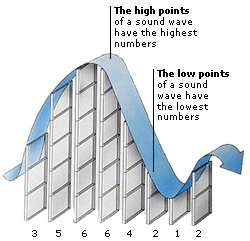DK Science & Technology: Sound
Our world is full of sounds. Sound is a form of energy that travels as SOUND WAVES. As well as making and hearing sounds, we also record them. Today, many recordings are made using DIGITAL SOUND.
Sound is made when something moves or vibrates. The movement sets up a sound wave in the surrounding air. Continuous sounds, such as drumming, are made when an object vibrates back and forth. A sudden clap or bang sends out a single sharp pulse of sound called a shock wave. The shock wave from an explosion can knock people over.
Stringed instruments (such as violins) have a series of stretched strings, which vibrate when they are plucked or stroked. Players of wind instruments (such as flutes) blow across or into a mouthpiece to force columns of air to vibrate in tubes or pipes. Percussion instruments (such as drums) vibrate when they are struck.
Sounds are different because sound waves have different frequencies. The frequency is the number of vibrations or sound waves produced in a second. We sometimes describe frequency as pitch. High-pitched sounds, such as from whistles, have a higher frequency (more waves per second) than low-pitched sounds, such as from bass drums.
A wine glass has a natural frequency at which it vibrates. A singer can break the glass by singing a note at the same frequency. Because the frequencies match, energy transfers from the sound to the glass until its vibrations become so strong it shatters. This is called resonance. Resonance is used to strengthen the sound in some types of musical instrument.
Frequency (the number of vibrations or waves per second) is measured in hertz (Hz). Low-pitched sounds have low frequencies; high-pitched sounds have high frequencies. There is an enormous variety of sounds in the animal world, and different types of animals make, and hear, sounds of different frequencies.
Bats hunt and fly at night. To help them find their way in the dark, they make a series of very high-frequency clicks (which humans cannot hear). Then they use their sensitive ears to listen for the echoes bouncing back off objects in their path.
To attract females, male grasshoppers make a loud rasping sound by scraping their hardened wing cases across a comblike series of pegs on their back legs. Grasshoppers have ears on their abdomens.
The loud hooting call of a howler monkey can travel for several miles through the dense forest where it lives. A hollow space in its neck bones works like an amplifier to strengthen the call through resonance.
Human hearing is not as sensitive as that of a bat or a dog, but we do make a wide range of sounds. Using the air in our lungs, we vibrate the vocal cords in our throat to make complicated sound patterns. We cry, scream, laugh, sigh, speak, and sing.
A male frog croaks to attract a female. The frog puffs up a pouch of skin under its jaw. Then it forces air through its vocal cords to make them vibrate. The air in the pouch picks up the vibration and strengthens it by resonance, making the sound louder.
A vibrating object moves back and forth. As it moves forward, it pushes against the air around it, compressing or squashing it. As it moves backward, it lets the air spread out. These squashing and expanding movements create a sound wave.
The energy in a sound wave moves outward from its source, passing from air molecule to air molecule in a series of pulses called compressions (air is squashed) and rarefactions (air is spread out). Sound travels easily through air.
A microphone changes sound waves into electrical signals that rise and fall in the same pattern as the sound. Analog recordings store the pattern as a wavy groove cut into a plastic disc (record), or as a magnetic pattern on a plastic tape.
Sound can be recorded or transmitted as a digital signal. A digital signal holds the pattern of a sound wave as a series of numbers that can be stored on CD or digital tape, or on a computer. When the signal is played, it changes back into sound waves.
Analog recordings rely on making an exact copy of the sound-wave pattern. But making more copies of the original recording can distort the pattern and add extra noises (hiss, for example). Because a digital recording is just numbers, it can be copied and corrected, if necessary, over and over again.
Different instruments make sounds with a mixture of different frequencies. By making sounds with the right mix of frequencies, an electronic synthesizer can imitate any instrument in an orchestra. A computer helps the player to arrange the sounds into music.

